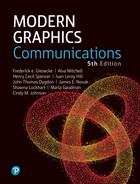 Walkthrough
by Shawna E. Lockhart, Cindy Johnson, Marla Goodman
Modern Graphics Communication, Fifth Edition
Walkthrough
by Shawna E. Lockhart, Cindy Johnson, Marla Goodman
Modern Graphics Communication, Fifth Edition
- Cover Page
- Title Page
- Copyright Page
- About this Book
- Acknowledgments
- Walkthrough
- Brief Contents
- Contents
- Chapter One. The Worldwide Graphic Language for Design
- Overview
- Understanding the Role of Technical Drawings
- 1.1 Graphics Tools in Action
- 1.2 Rapid Prototyping
- 1.3 Drafting Standards
- 1.4 Creativity Techniques
- 1.5 Product Definition
- 1.6 Showing the Design Process in a Portfolio
- Key Words
- Chapter Summary
- Review Questions
- Chapter Exercises
- Reverse Engineering Projects
- Chapter Two. Layouts and Lettering
- Overview
- Understanding Projections
- 2.1 Alphabet of Lines
- 2.2 Freehand Lines
- 2.3 Measurement Systems
- 2.4 Drawing Scale
- 2.5 Specifying the Scale on a Drawing
- 2.6 Lettering
- 2.7 Lettering Standards
- 2.8 Using Guidelines for Hand Lettering
- 2.9 Vertical and Inclined Letters and Numerals
- 2.10 Fractions
- 2.11 Spacing of Letters and Words
- 2.12 Lettering for Titles
- 2.13 Drawing Pencils
- 2.14 Templates
- 2.15 CAD Tools
- 2.16 Sketching and Drawing Media
- 2.17 Standard Sheets
- 2.18 Standard Layout Elements
- 2.19 Layouts
- 2.20 Planning Your Drawing or Sketch
- Key Words
- Chapter Summary
- Worksheets
- Review Questions
- Chapter Exercises
- Chapter Three. Visualization and Sketching
- Overview
- Understanding Solid Objects
- Understanding Sketching Techniques
- 3.1 Technique of Lines
- 3.2 Sketching Straight Lines
- 3.3 Sketching Circles, Arcs, and Ellipses
- 3.4 Maintaining Proportions
- 3.5 One-View Drawings
- 3.6 Pictorial Sketching
- 3.7 Projection Methods
- 3.8 Axonometric Projection
- 3.9 Isometric Projection
- 3.10 Isometric Drawings
- 3.11 Making an Isometric Drawing
- 3.12 Offset Location Measurements
- 3.13 Hidden Lines and Centerlines
- 3.14 Angles in Isometric
- 3.15 Irregular Objects
- 3.16 Curves in Isometric
- 3.17 True Ellipses in Isometric
- 3.18 Orienting Ellipses in Isometric Drawings
- 3.19 Drawing Isometric Cylinders
- 3.20 Screw Threads in Isometric
- 3.21 Arcs in Isometric
- 3.22 spheres in Isometric
- 3.23 Oblique Sketches
- 3.24 Length of Receding Lines
- 3.25 Choice of Position in Oblique Drawings
- 3.26 Ellipses for Oblique Drawings
- 3.27 Angles in Oblique Projection
- 3.28 Sketching Assemblies
- 3.29 Sketching Perspectives
- 3.30 Curves and Circles in Perspective
- 3.31 Shading
- 3.32 Computer Graphics
- 3.33 Drawing on Drawing
- Key Words
- Chapter Summary
- Worksheets
- Review Questions
- Sketching Exercises
- Chapter Four. Geometry for Modeling and Design
- Overview
- Coordinates for 3D CAD Modeling
- Geometric Entities
- 4.1 Manually Bisecting a Line or Circular Arc
- 4.2 Drawing Tangents to Two Circles
- 4.3 Drawing an Arc Tangent to a Line or Arc and through a Point
- 4.4 Bisecting an Angle
- 4.5 Drawing a Line Through a Point and Parallel to a Line
- 4.6 Drawing a Triangle with Sides Given
- 4.7 Drawing a Right Triangle with Hypotenuse and One Side Given
- 4.8 Laying Out an Angle
- 4.9 Drawing an Equilateral Triangle
- 4.10 Polygons
- 4.11 Drawing a Regular Pentagon
- 4.12 Drawing a Hexagon
- 4.13 Ellipses
- 4.14 Spline Curves
- 4.15 Geometric Relationships
- 4.16 Solid Primitives
- 4.17 Recognizing Symmetry
- 4.18 Extruded Forms
- 4.19 Revolved Forms
- 4.20 Irregular Surfaces
- 4.21 User Coordinate Systems
- 4.22 Transformations
- Key Words
- Chapter Summary
- Worksheets
- Skills Summary
- Review Questions
- Chapter Exercises
- Chapter Five. Modeling and Design
- Overview
- Refinement and Modeling
- Kinds of Models
- 5.1 2D Models
- 5.2 3D Models
- 5.3 Types of 3D Models
- 5.4 Constraint-Based Modeling
- 5.5 Constraints Define the Geometry
- 5.6 Planning Parts for Design Flexibility
- 5.7 Sketch Constraints
- 5.8 The Base Feature
- 5.9 Editing the Model
- 5.10 Constraint-Based Modeling Modes
- 5.11 Choosing the Right Modeling Method
- Key Words
- Chapter Summary
- Review Questions
- Chapter Exercises
- Chapter Six. Orthographic Projection
- Overview
- Understanding Projections
- 6.1 Hidden Line Technique
- 6.2 Precedence of Lines
- 6.3 Centerlines
- 6.4 Laying Out a Drawing
- 6.5 Developing Views From 3D Models
- 6.6 Visualization
- 6.7 Views of Surfaces
- 6.8 Normal Surfaces
- 6.9 Inclined Surfaces
- 6.10 Oblique Surfaces
- 6.11 Edges
- 6.12 Normal Edges
- 6.13 Inclined Edges
- 6.14 Oblique Edges
- 6.15 Parallel Edges
- 6.16 Angles
- 6.17 Vertices
- 6.18 Interpreting Points
- 6.19 Interpreting Lines
- 6.20 Similar Shapes of Surfaces
- 6.21 Interpreting Views
- 6.22 Models
- 6.23 Projecting a Third View
- 6.24 Becoming a 3D Visualizer
- Key Words
- Chapter Summary
- Worksheets
- Review Questions
- Chapter Exercises
- Chapter Seven. 2D Drawing Representation
- Overview
- Practices for 2D Documentation Drawings
- 7.1 Visualizing and Drawing Complex Cylindrical Shapes
- 7.2 Cylinders When Sliced
- 7.3 Cylinders and Ellipses
- 7.4 Intersections and Tangencies
- 7.5 Fillets and Rounds
- 7.6 Runouts
- 7.7 Conventional Edges
- 7.8 Necessary Views
- 7.9 Partial Views
- 7.10 Alignment of Views
- 7.11 Removed Views
- 7.12 Right-Hand and Left-Hand Parts
- 7.13 Revolution Conventions
- Key Words
- Chapter Summary
- Review Questions
- Chapter Exercises
- Chapter Eight. Section Views
- Overview
- Understanding Sections
- 8.1 Placement of Section Views
- 8.2 Labeling Cutting Planes
- 8.3 Line Precedence
- 8.4 Rules for Lines in Section Views
- 8.5 Cutting-Plane Line Style
- 8.6 Section-Lining Technique
- 8.7 Half Sections
- 8.8 Broken Out Sections
- 8.9 Revolved Sections
- 8.10 Removed Sections
- 8.11 Offset Sections
- 8.12 Ribs in Section
- 8.13 Aligned Sections
- 8.14 Partial Views
- 8.15 Intersections in Sections
- 8.16 Conventional Breaks and Sections
- 8.17 Assembly Sections
- Key Words
- Chapter Summary
- Worksheets
- Review Questions
- Chapter Exercises
- Chapter Nine. Auxiliary Views
- Overview
- Understanding Auxiliary Views
- 9.1 Using Triangles to Sketch Auxiliary Views
- 9.2 Using Grid Paper to Sketch Auxiliary Views
- 9.3 Using CAD to Create Auxiliary Views
- 9.4 Circles and Ellipses in Auxiliary Views
- 9.5 Hidden Lines in Auxiliary Views
- 9.6 Partial Auxiliary Views
- 9.7 Half Auxiliary Views
- 9.8 Reverse Construction
- 9.9 Auxiliary Sections
- 9.10 Viewing-Plane Lines and Arrows
- 9.11 Uses of Auxiliary Views
- 9.12 True Length of a Line
- 9.13 Point View of a Line
- 9.14 Edge View of a Plane
- 9.15 True Size of an Oblique Surface
- 9.16 Dihedral Angles
- Understanding Developments and Intersections
- 9.17 Developments
- 9.18 Hems and Joints for Sheet Metal and Other Materials
- 9.19 More Examples of Developments and Intersections
- 9.20 Transition Pieces
- 9.21 Triangulation
- 9.22 Developing a Transition Piece Connecting Rectangular Pipes on the Same Axis
- 9.23 Developing a Plane and a Sphere
- 9.24 Revolution
- 9.25 Primary and Successive Revolutions
- 9.26 True Length of a Line: Revolution Method
- Key Words
- Worksheets
- Chapter Summary
- Review Questions
- Chapter Exercises
- Chapter Ten. Modeling for Manufacture and Assembly
- Overview
- Design for Manufacture, Assembly, Disassembly, and Service
- 10.1 Assembly Models
- 10.2 Assemblies and Design
- 10.3 Assemblies and Simulation
- 10.4 Parts for Assemblies
- 10.5 Using Your Model to Check Fits
- 10.6 Manufacturing Processes
- 10.7 Dos and Don’ts of Practical Design
- 10.8 Manufacturing Materials
- 10.9 Appearance, Service Life, and Recycling
- 10.10 Dimensional Accuracy and Surface Finish
- 10.11 Net-Shape Manufacturing
- 10.12 Computer-Integrated Manufacturing
- 10.13 Shared Manufacturing
- 10.14 Manufacturing Methods and the Drawing
- 10.15 Modeling for Testing and Refinement
- 10.16 Determining Mass Properties
- 10.17 Exporting Data From the Database
- 10.18 Downstream Applications
- 10.19 Prototyping Your Design
- Key Words
- Chapter Summary
- Skills Summary
- Review Questions
- Chapter Exercises
- Chapter Eleven. Dimensioning
- Overview
- Understanding Dimensioning
- 11.1 Lines Used in Dimensioning
- 11.2 Using Dimension and Extension Lines
- 11.3 Arrowheads
- 11.4 Leaders
- 11.5 Drawing Scale and Dimensioning
- 11.6 Direction of Dimension Values and Notes
- 11.7 Dimension Units
- 11.8 Millimeter Values
- 11.9 Decimal-Inch Values
- 11.10 Rules for Dimension Values
- 11.11 Rules for Rounding Decimal Dimension Values
- 11.12 Dual Dimensioning
- 11.13 Combination Units
- 11.14 Dimensioning Symbols
- 11.15 Placing and Showing Dimensions Legibly
- 11.16 Superfluous Dimensions
- 11.17 Dimensioning Angles
- 11.18 Dimensioning Arcs
- 11.19 Fillets and Rounds
- 11.20 Size Dimensioning: Prisms
- 11.21 Size Dimensioning: Cylinders
- 11.22 Size Dimensioning: Holes
- 11.23 Applying Standard Dimensioning Symbols
- 11.24 Dimensioning Counterbores and Spotfaces with Fillets
- 11.25 Dimensioning Triangular Prisms, Pyramids, and Cones
- 11.26 Dimensioning Curves
- 11.27 Dimensioning Curved Surfaces
- 11.28 Dimensioning Rounded-End Shapes
- 11.29 Dimensioning Threads
- 11.30 Dimensioning Tapers
- 11.31 Dimensioning Chamfers
- 11.32 Shaft Centers
- 11.33 Dimensioning Keyways
- 11.34 Dimensioning Knurls
- 11.35 Finish Marks
- 11.36 Surface Roughness
- 11.37 Location Dimensions
- 11.38 Mating Dimensions
- 11.39 Coordinate Dimensioning
- 11.40 Tabular Dimensions
- 11.41 Dimensioning for Numerically-Controlled Machining
- 11.42 Machine, Pattern, and Forging Dimensions
- 11.43 Sheet Metal Bends
- 11.44 Notes
- 11.45 Standards
- 11.46 Dos and Don’ts of Dimensioning
- Key Words
- Worksheets
- Chapter Summary
- Review Questions
- Chapter Exercises
- Chapter Twelve. Tolerancing
- Overview
- Understanding Tolerance
- 12.1 Specifying Tolerances
- 12.2 General Tolerance Notes
- 12.3 Limit Tolerances
- 12.4 Plus-or-Minus Tolerances
- 12.5 Tolerance Stacking
- 12.6 Using American National Standard Limits and Fit Tables
- 12.7 Tolerances and Machining Processes
- 12.8 Metric System of Tolerances and Fits
- 12.9 Preferred Sizes
- 12.10 Preferred Fits
- 12.11 Geometric Dimensioning and Tolerancing
- 12.12 Symbols for Tolerances of Position and Form
- 12.13 Datum Features
- 12.14 Positional Tolerances
- 12.15 Maximum Material Condition
- 12.16 Tolerances of Angles
- 12.17 Form Tolerances for Single Features
- 12.18 Orientations for Related Features
- 12.19 Using Geometric Dimensioning and Tolerancing
- 12.20 Tolerances and Digital Product Definition
- 12.21 Computer Graphics
- Key Words
- Chapter Summary
- Worksheets
- Review Questions
- Chapter Exercises
- Chapter Thirteen. Threads, Fasteners, and Springs
- Overview
- Understanding Threads and Fasteners
- 13.1 Thread Notes
- 13.2 External Thread Symbols
- 13.3 Internal Thread Symbols
- 13.4 Detailed Representation: Metric, Unified, and American National Threads
- 13.5 Threads in Assembly
- 13.6 Modeling Thread
- 13.7 American National Standard Pipe Threads
- 13.8 Use of Phantom Lines
- 13.9 Tapped Holes
- 13.10 Bolts, Studs, and Screws
- 13.11 Standard Bolts and Nuts
- 13.12 Drawing Standard Bolts
- 13.13 Specifications for Bolts and Nuts
- 13.14 Locknuts and Locking Devices
- 13.15 Standard Cap Screws
- 13.16 Standard Machine Screws
- 13.17 Standard Set Screws
- 13.18 American National Standard Wood Screws
- 13.19 Miscellaneous Fasteners
- 13.20 Keys
- 13.21 Machine Pins
- 13.22 Rivets
- 13.23 Springs
- 13.24 Drawing Helical Springs
- 13.25 Modeling Springs
- Key Words
- Worksheets
- Chapter Summary
- Review Questions
- Chapter Exercises
- Chapter Fourteen. Working Drawings
- Overview
- 14.1 Subassemblies
- 14.2 Identification
- 14.3 Parts Lists
- 14.4 Assembly Sections
- 14.5 Working Drawing Assembly
- 14.6 Installation Assemblies
- 14.7 Check Assemblies
- 14.8 Working Drawing Formats
- 14.9 Drawing Numbers
- 14.10 Zoning
- 14.11 Checking Drawings
- 14.12 Drawing Revisions
- 14.13 Simplifying Drawings
- 14.14 Patent Drawings
- Key Words
- Chapter Summary
- Review Questions
- Chapter Exercises
- Chapter Fifteen. Axonometric Projection
- Overview
- Understanding Axonometric Projection
- 15.1 Dimetric Projection
- 15.2 Approximate Dimetric DrawingS
- 15.3 Trimetric Projection
- 15.4 Trimetric Scales
- 15.5 Trimetric Ellipses
- 15.6 Axonometric Projection Using Intersections
- 15.7 Computer Graphics
- 15.8 Oblique Projections
- 15.9 Ellipses for Oblique Drawings
- 15.10 Offset Measurements
- 15.11 Oblique Dimensioning
- 15.12 Computer Graphics
- Key Words
- Chapter Summary
- Review Questions
- Chapter Exercises
- Chapter Sixteen. Perspective Drawings
- Overview
- Understanding Perspectives
- 16.1 Perspective From a Multiview Projection
- 16.2 Nonrotated Side View Method for Perspective
- 16.3 Drawing an Angular Perspective
- 16.4 Position of the Station Point
- 16.5 Location of the Picture Plane
- 16.6 Bird’s-Eye View or Worm’s-Eye View
- 16.7 The Three Types of Perspectives
- 16.8 One-Point Perspective
- 16.9 One-Point Perspective of a Cylindrical Shape
- 16.10 Two-Point Perspective
- 16.11 Three-Point Perspective
- 16.12 Measurements in Perspective
- 16.13 Direct Measurements Along Inclined Lines
- 16.14 Vanishing Points of Inclined Lines
- 16.15 Inclined Lines in Perspective, Joining Endpoint Method
- 16.16 Curves and Circles in Perspective
- 16.17 The Perspective Plan Method
- 16.18 Perspective Diagram
- 16.19 Shading
- 16.20 Computer Graphics
- Key Words
- Chapter Summary
- Review Questions
- Chapter Exercises
- Glossary
- Appendices
- 1 Useful Formulas for Geometric Entities
- 2 Running and Sliding Fits—American National Standard
- 3 Clearance Locational Fits—American National Standard
- 4 Transition Locational Fits—American National Standard
- 5 Interference Locational Fits—American National Standard
- 6 Force and Shrink Fits—American National Standard
- 7 International Tolerance Grades
- 8 Preferred Metric Hole Basis Clearance Fits—American National Standard
- 9 Preferred Metric Hole Basis Transition and Interference Fits—American National Standard
- 10 Preferred Metric Shaft Basis Clearance Fits— American National Standard
- 11 Preferred Metric Shaft Basis Transition and Interference Fits—American National Standard
- 12 Screw Threads, American National, Unified, and Metric
- 13 Twist Drill Sizes—American National Standard and Metric
- 14 Acme Threads, General Purpose
- 15 Bolts, Nuts, and Cap Screws—Square and Hexagon— American National Standard and Metric
- 16 Cap Screws, Slotted and Socket Head—American National Standard and Metric
- 17 Machine Screws—American National Standard and Metric
- 18 Keys—Square, Flat, Plain Taper, and Gib Head
- 19 Screw Threads, Square and Acme
- 20 Woodruff Keys—American National Standard
- 21 Woodruff Key Sizes for Different Shaft Diameters
- 22 Pratt and Whitney Round-End Keys
- 23 Washers, Plain—American National Standard
- 24 Washers, Lock—American National Standard
- 25 Wire Gage Standards
- 26 Taper Pins—American National Standard
- 27 Cotter Pins—American National Standard
- 28 Form and Proportion of Datum Symbols
- 29 Form and Proportion of Geometric Characteristic Symbols
- 30 Form and Proportion of Geometric Dimensioning Symbols
- 31 Form and Proportion of Modifying Symbols
- 32 Form and Proportion of Dimensioning Symbols and Letters
- 33 Comparison of Symbols
- 34 Types of Scales
- 35 Additional Geometric constructions
- Index
- Worksheets
- Worksheet 1 Practice sketching freehand lines
- Worksheet 2 Measurements and Scale
- Worksheet 3 Vertical lettering practice
- Worksheet 4 1/8 inch lettering practice
- Worksheet 5 Using Negative Space
- Worksheet 6 Sketching circles and ellipses
- Worksheet 7 Practicing line and curve technique
- Worksheet 8 Blocking in the irregular object
- Worksheet 9 Sketching to Scale
- Worksheet 10 Sketching an isometric pictorial
- Worksheet 11 Sketching curved shapes in isometric
- Worksheet 12 Creating an oblique sketch of an object
- Worksheet 13 Using Boolean operators
- Worksheet 14 The Glass Box
- Worksheet 15 Transferring Depth Dimensions
- Worksheet 16 Blocking a multiview drawing
- Worksheet 17 Practice with hidden lines
- Worksheet 18 Projecting inclined surfaces
- Worksheet 19 Practice with centerlines
- Worksheet 20 Sketching Full Sections
- Worksheet 21 Sketching Full Sections
- Worksheet 22 Sketching a full section
- Worksheet 23 Sketching a half section
- Worksheet 24 Creating an aligned section
- Worksheet 25 The auxiliary view glass box
- Worksheet 26 Plotting curves
- Worksheet 27 Developing a prism
- Worksheet 28 Developing a cylinder
- Worksheet 29 Dimensioning
- Worksheet 30 Dimensioning
- Worksheet 31 Dimensioning
- Worksheet 32 Dimensioning technique
- Worksheet 33 Determining allowances and clearances
- Worksheet 34 Sketching dimensions with tolerances
- Worksheet 35 Sketching thread symbols
- Inside Front Cover
- Inside Back Cover
Walkthrough
The following features were designed to provide easy navigation and quick reference for students and professionals who look to Giesecke both as a helpfully-organized teaching text and a lasting reference.
Chapter Opener

“Spotlight” Sections
These sections add background information for key topics.
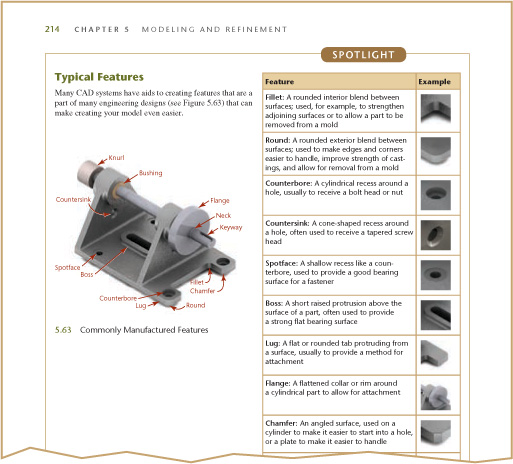
“Foundations” Section
This introductory section covers the chapter topic’s usage and importance, visualization tips, and theory related to the drawing and modeling techniques.
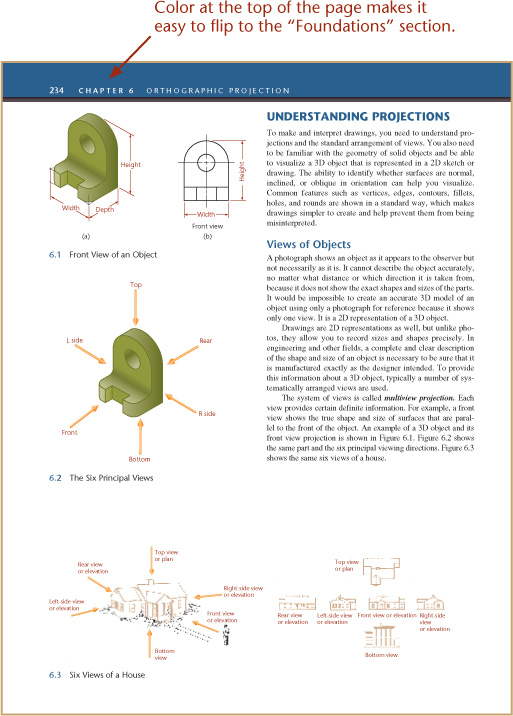
“Detail” Section
This is the “brass tacks” of the book, where detailed techniques, variations, and examples are organized into quick-read sections, numbered for easy reference.
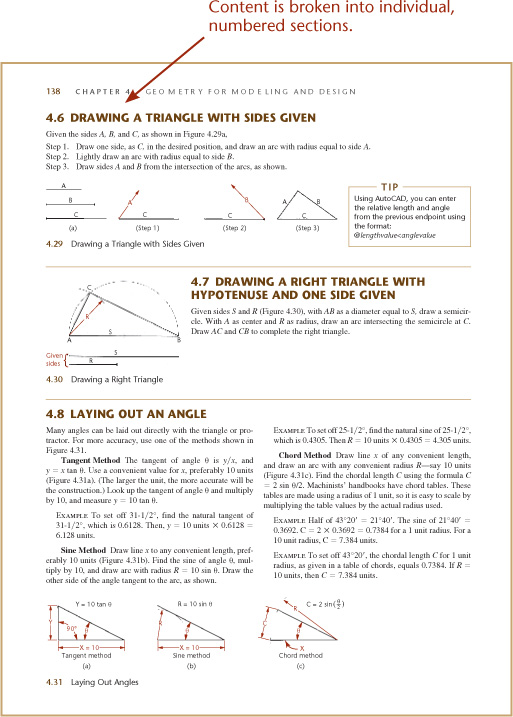
“Step by Step” Activities
Complicated processes are shown as step-by-step activities with each illustration right next to the text that explains it.
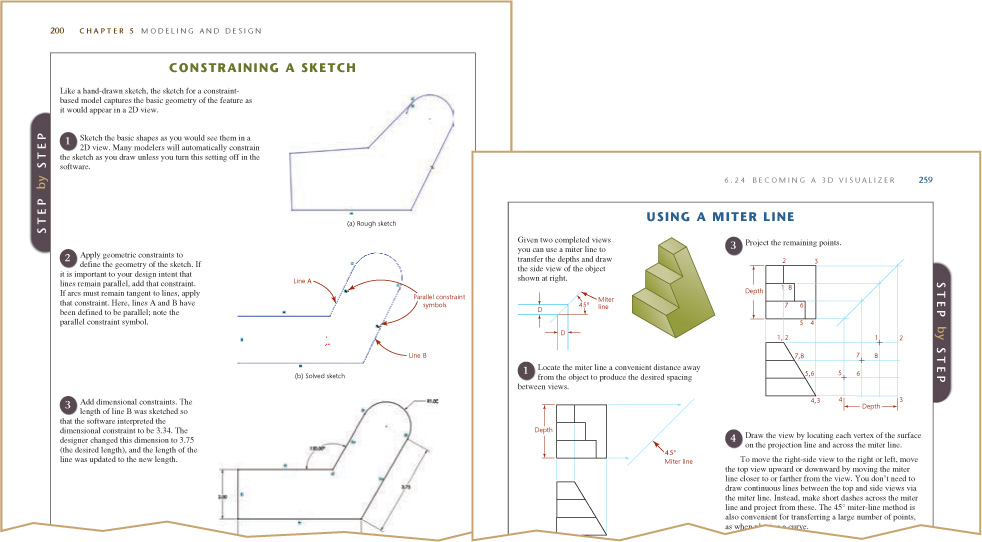
“CAD at Work”
CAD at Work sections break out examples related to using the 2D or 3D CAD model to generate drawings.
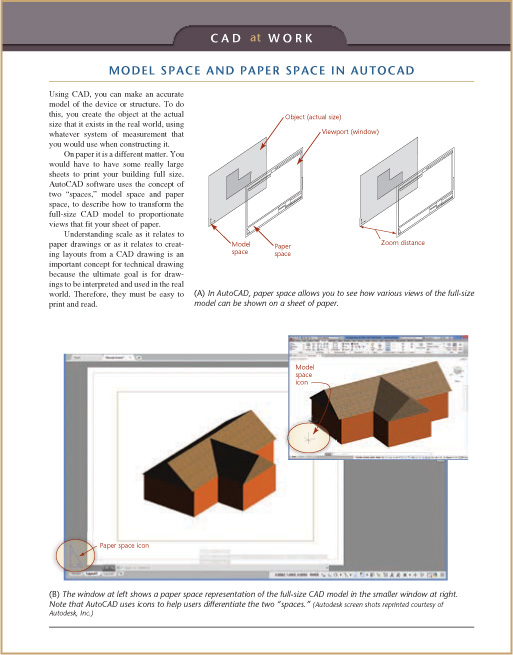
“Industry Case”
Several industry practitioners share their approaches to modeling and documenting design.

“Portfolio”
These pages offer examples of finished drawings showing real-world application of topics presented.
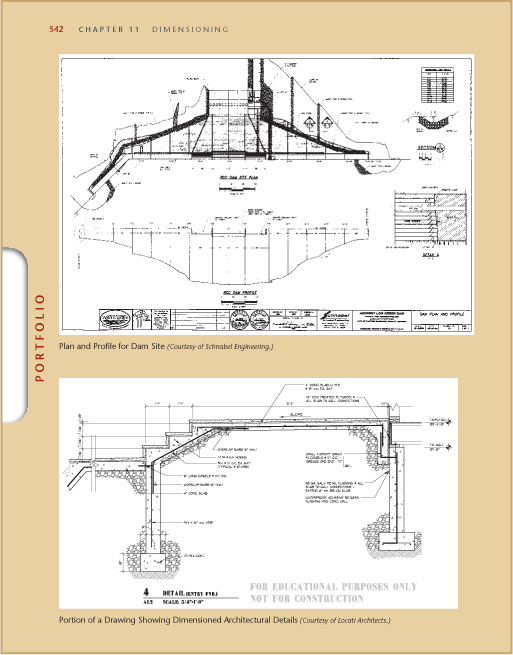
Solid Model Visualization Art
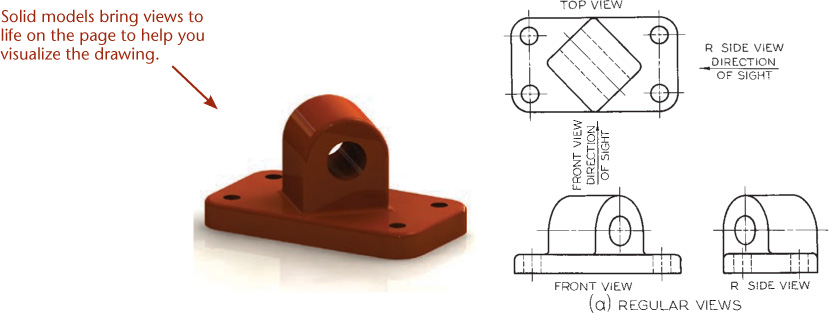
Illustrations
Colored callouts differentiate explanatory text from annotations in technical drawings. Consistent use of color helps differentiate the meaning of projection lines, fold lines, and other drawing elements. A color key is provided for easy reference.
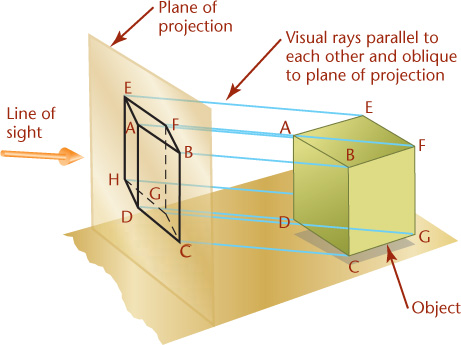
Color Key for Instructional Art
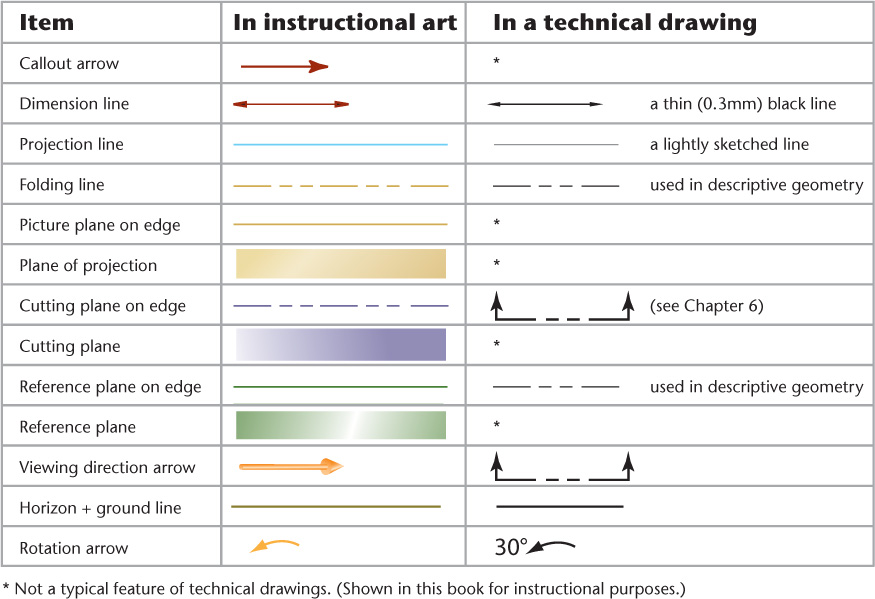
Chapter Review
Each chapter ends with Key Words, a Chapter Summary, and Review Questions.
Chapter Exercises
The Giesecke problem sets feature updated exercises including plastic and sheet metal parts, constraint-based modeling, sketching problems, and reverse engineering projects.
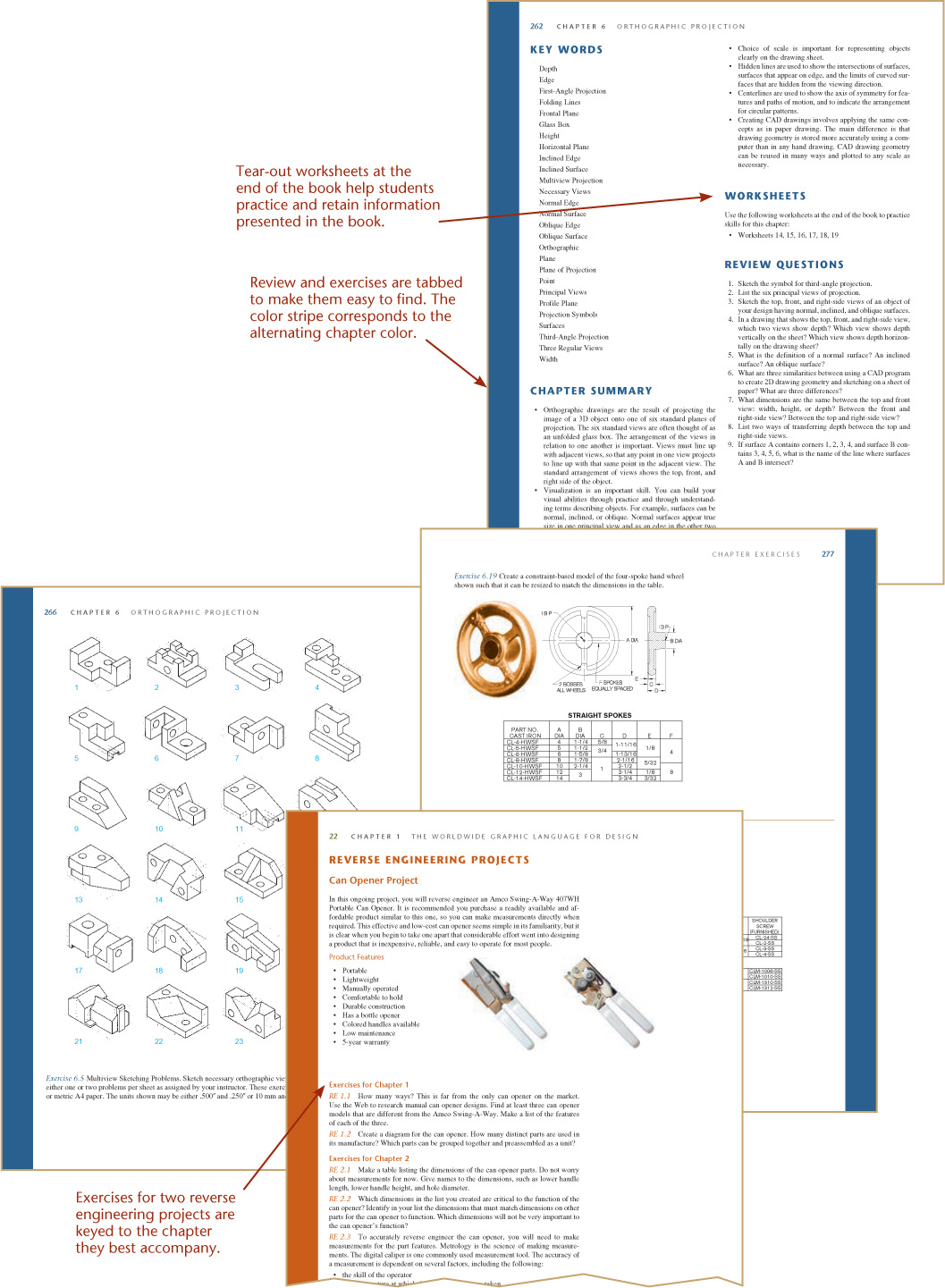
-
No Comment